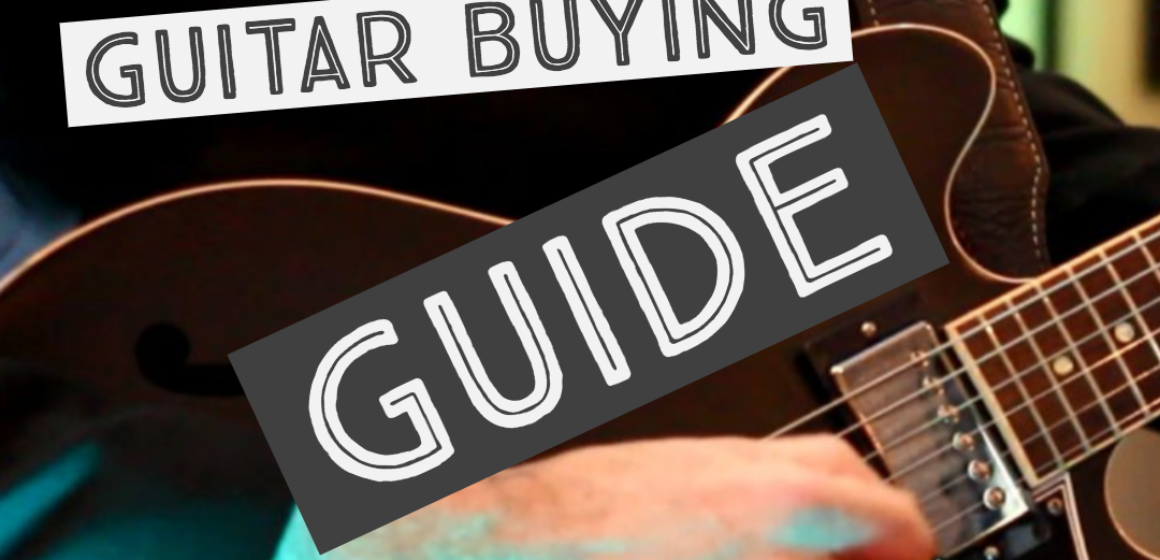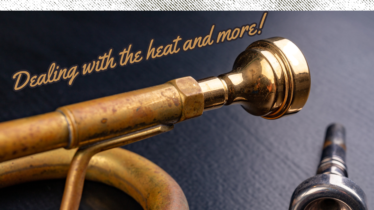
Congratulations on taking your first step towards owning a guitar! If you haven’t purchased a guitar before, the process can be very confusing and frustrating. The following guitar buying guide will help you zero in on the best kind of guitar that fits your specific musical needs.
Sizing: How old (or how big) is the student?
Not all guitars are created equal. As a matter of fact, no two guitars are alike! One of the most noticeable differences is size. The most common size categories are as follows:
- ¼ Size – This guitar is VERY small and is almost like a ukulele. It’s best for very young and small children.
- ½ Size – As the name suggests, this guitar is half the size of a standard guitar. It’s best for very young children who may be bigger than their classmates.
- ¾ Size – This guitar is for elementary school children and is just a little smaller than a standard guitar. Children benefit by using this instrument because their hands are the right size to reach all of the strings, frets, and positions comfortably.
- Standard Size – This is the traditional adult guitar. Most students from middle school to adult are ready for this kind of instrument.
- Over-Sized – This guitar is bigger, heftier, and richer in tone quality than standard-size guitars.
After years of teaching guitar, I find that purchasing the largest comfortable instrument is the best. Children grow quickly, and several months of stretching extra hard on a standard size guitar will pay off in the long run when they grow into it (it will help them get those tricky chords!). This is better than spending money on a ¾ size only to have them outgrow it and require a larger instrument within the year. Always test a couple of guitar sizes out and see what feels best.
Different Types of Guitars
Now that you know what size you need, it’s time to determine what type of guitar is best for you. The most common kinds of guitars are below:
- Acoustic – This guitar has six steel strings and is hollow. This is the best choice for beginners. Ninety-nine percent of the time, I advise students who do not currently have a guitar to purchase an acoustic instrument. The acoustic guitar is extremely adaptable, and most songs from widely disparate genres sound good on it!
- Classical – This guitar has six strings, four of which are nylon and two of which are steel. It is hollow and has a very wide neck. It is common in Latin music and folk styles, like Flamenco, use it. This is best for students who want to pursue Classical Guitar as their primary focus.
- Electric Solid Body – This guitar has six steel strings and is not hollow. It is usually very thin and sleek. It requires amplification to be heard clearly, but is the best choice for beginners who want to play predominantly in the rock genres (punk, classic rock, progressive rock, metal, etc.).
- Electric Semi-Hollow Body – This guitar has six steel strings and is slightly bulkier than the electric solid body. It also requires amplification to be heard clearly, but some sound is produced by the hollow cavities in its body. These guitars are more expensive and are best saved for intermediate and advanced playing. They are common in jazz, pop, folk, and some rock genres.
- Electric Hollow Body – This guitar has six steel strings and is usually quite large. It is hollow like an acoustic guitar, but it still can be amplified for maximum sound. These guitars can be incredibly expensive and are best for advanced musicians. Jazz predominantly features them.
- Others – The guitar family has lots of weird and unusual members. Some of the most common outliers are the Twelve-String, Eight-String, Seven-String, Double-Neck, and Dobro (Slide Guitar). Unless you have a specific need or interest in one of these specialties, it is best to stay away from these until you are ready for advanced playing.
A note for those deciding between acoustic and electric: Tension on the acoustic guitar’s strings is higher than the electric family, but that really benefits new students. It is so much easier to begin playing on an acoustic guitar and then switch to an electric guitar than to go the other way. Oftentimes, when students begin on an electric and try to pick up an acoustic guitar, they get frustrated and feel defeated where acoustic players usually find electric instruments easy to play.
Value and Brands
There are many different guitar manufactures. Excellent guitars are made all over the world – country of origin doesn't matter. To find the best instrument for you, it’s best to think in terms of price bracket. If a guitar is very expensive, there’s a very good reason for it. Likewise, if a deal seems too good to be true, stay away! The guitar market is very competitive and it is uncommon to find an instrument that is severely overpriced or underpriced. The following outlines some reliable brands for varying ability levels:
- Beginner: Yamaha, Takamine, Ibanez, Washburn, Squier
- Intermediate: Ibanez, Fender, Epiphone, Gretsch, Jackson, ESP, Schecter, Yamaha, Washburn, Takamine
- Advanced: Ibanez, Gibson, Fender, Paul Reed Smith, Taylor, Martin, Rickenbacker
This guitar buying guide is heavily based on my opinion and experiences. I play Ibanez instruments nearly exclusively and can’t compliment them enough. However, I know that the other manufacturers above produce excellent instruments.
Be aware that some manufactures mark up their prices based on name recognition. For example, an intermediate Fender guitar may be one hundred dollars more than an Ibanez of the same quality. The absolute best way to tell if the guitar is right for you is to play it and see how it feels in your hands. Be advised to stay away from Taylor, Martin, and custom models of the advanced brands until you are absolutely ready. They can be very expensive!
Below are some guitar brands to avoid. Purchasing one will likely set you up for frustration and disappointment. A lot of guitar technique is dependent on you having a well-made instrument. If your instrument isn’t up to snuff, then how will you be?
Never buy: First Act, Applause, Spectrum, Daisy Rock, Ovation, Crescent, big brand knock-offs, community carnival guitars, and anything that you don’t recognize!
The Perfect Guitar
Still don’t know which one to buy? That is okay! Your priorities should be as follows:
- Does the guitar feel good when I play it? It should feel nice in your hands.
- Does the guitar fit my price range? (I recommend buying the best quality instrument that you can afford without breaking the bank)
- Do I like the way that the guitar looks? If it makes you happy to see it, you’ll want to play it! The ideal guitar is both an excellent instrument and a great conversation piece.
If you can satisfy all three priorities with one instrument, then you’ve found the one! If a guitar doesn’t quite fit, then it’s time to keep looking.
Where to Shop
I purchase nearly all of my instruments on Craigslist, Facebook marketplace or locally from other musicians. There really is no reason to buy a brand-new guitar when there are so many excellent used instruments available. Please exercise caution when using Craigslist or other internet services that require you to meet with strangers.
If the above sounds out of your comfort zone, you can find great used instruments (as well as shiny new ones!) at Guitar Center, Sam Ash, and other music stores. I recommend purchasing your first guitar at a big-box store so that you can play it and compare it to other similar instruments. If you must purchase online through Amazon, eBay, Sweetwater, various music stores, or other companies, be sure to check the insurance policy for shipment as well as the return policy.
Keep in mind that some brands and manufacturers are designed for easy modification. If you enjoy taking things apart or tinkering with projects, you might enjoy purchasing a cheaper “project” guitar and replacing parts to make it sound extraordinary. My current performance guitar is a project guitar – I made an intermediate-level Mexican Fender Stratocaster sound like it cost thousands of dollars by a weekend of modification work and around fifty dollars in parts.
Final Considerations
The guitar must feel good beneath your fingers! The biggest culprit for uncomfortable playing is action, or how far away the strings are from the fretboard. If the strings are too high, it is usually a simple fix. All new guitars need a professional set-up. If you are purchasing from a reputable dealer such as Guitar Center or Sam Ash, you should ask for a set-up before leaving the store. Most companies include this in the purchase cost. If you are buying a used instrument or if a set-up isn’t included under the terms of your purchase, you should find a knowledgeable guitar teacher or luthier (guitar repairman and technician) to do it for you. Contact us for guitar repair and referrals!
Check what kind of strings are on the guitar. Strings come in varying thicknesses, or gauges. A beginner needs extra light or light gauge. It might not be a bad idea to purchase a new set of strings so that you are prepared when the guitar’s current strings get old or break.
You will probably need a guitar pick. Like strings, they also come in varying thicknesses. I wouldn’t recommend anything thicker than a medium for beginners. Picks also have a curious way of disappearing – it’s a great idea to purchase a pack!
It’s best to own a guitar strap as well. This makes playing more comfortable, plus you can stand and play! Be sure that the strap is something that looks aesthetically pleasing but is also kind to your shoulders. It is definitely worth it to pay a little extra for comfort.
Internet reviews are your friend! The guitar community is so large and diverse that most models have plenty of reviews. You can usually trust what your colleagues are saying.
Good luck on acquiring your first guitar, and congratulations on taking this exciting step! Looking for something else besides a guitar buying guide? Read our other blogs here.
This post contains affiliate links. We receive a small amount of compensation when you purchase from our links, which we almost always blow on new guitars!




